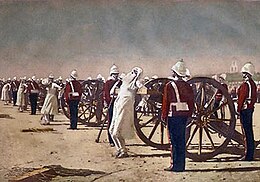
Blowing from a gun is a method of execution in which the victim is typically tied to the mouth of a cannon which is then fired, resulting in death. George Carter Stent described the process as follows:
The prisoner is generally tied to a gun with the upper part of the small of his back resting against the muzzle. When the gun is fired, his head is seen to go straight up into the air some forty or fifty feet; the arms fly off right and left, high up in the air, and fall at, perhaps, a hundred yards distance; the legs drop to the ground beneath the muzzle of the gun; and the body is literally blown away altogether, not a vestige being seen.[1]
Blowing from a gun was a reported means of execution as long ago as the 16th century and was used until the 20th century. The method was used by the Portuguese in the 16th and 17th centuries, from as early as 1509 across their empire from Ceylon (modern day Sri Lanka)[2] to Mozambique[3] to Brazil.[4] The Mughals used the method throughout the 17th century and into the 18th, particularly against rebels.[5]
This method of execution is most closely associated with the British East India Company rule in India. Following the Indian Rebellion of 1857, "blowing from a gun" was a method the British used to execute rebels[6] as well as for Indian sepoys who were found guilty of desertion.[7] Using the methods previously practised by the Mughals, the British began implementing blowing from guns in the latter half of the 18th century.[8]
Destruction of the body and scattering of the remains over a wide area had a religious function as a means of execution in the Indian subcontinent as it prevented the necessary funeral rites of Hindus and Muslims.[9] Accordingly, for believers the punishment was extended beyond death. This was well understood by foreign occupiers and the practice was not generally employed by them as concurrent foreign occupiers of Africa, Australasia, or the Americas. Most recently there was an exceptional use of the practice in Afghanistan in 1930, against 11 Panjshiri rebels.[10]
- ^ Havholm (2008), p. 77
- ^ Calcutta Review (1851), p. 395
- ^ Alden (1996), p. 55
- ^ Southey (1822), p.469
- ^ 17th century case, Afsos, Court (1871), p. 64, 18th century case Hazārah, McChesney, Khorrami (2012), p. 54
- ^ Long (1869), p. 397–398
- ^ February 1781 Parlby (1822), p. 188, May 1783 Baillie (1788), p. 490, July 1783 Forbes (1815), p. 123, October 1783 Forbes (1815), p. 133 November 1783 Baillie (1788), p. 468
- ^ Long (1869), p. 51 page 224
- ^ Past Present, Volume 233, Issue 1, November 2016, Pages 185-225, Calculated to Strike Terror: The Amritsar Massacre and the Spectacle of Colonial Violence by Kim A. Wagner, https://academic.oup.com/past/article/233/1/185/2915150/Calculated-to-Strike-Terror-The-Amritsar-Massacre
- ^ Cullather, Meyerowitz (2003), p. 50